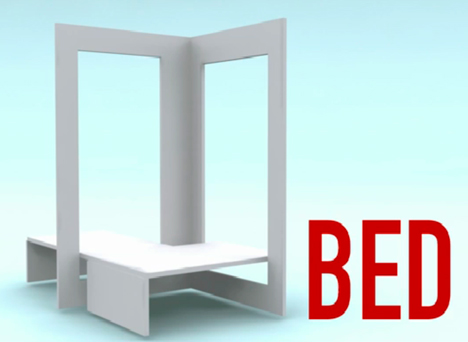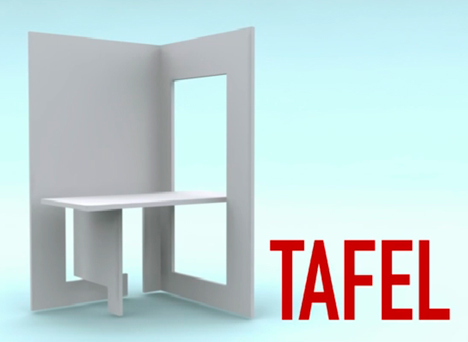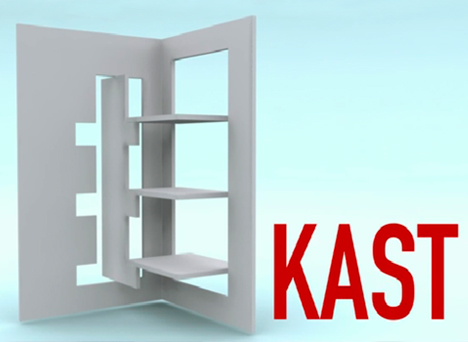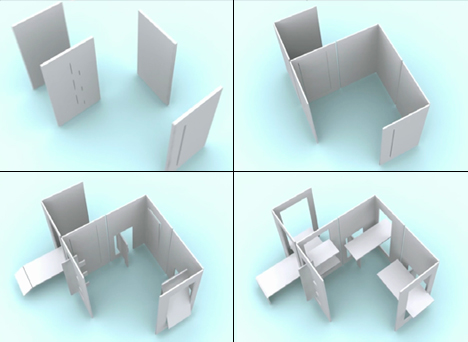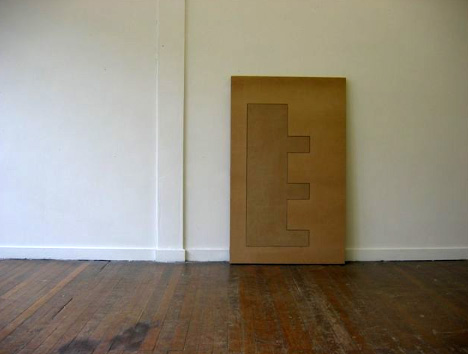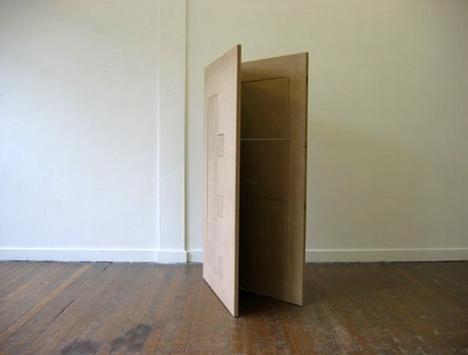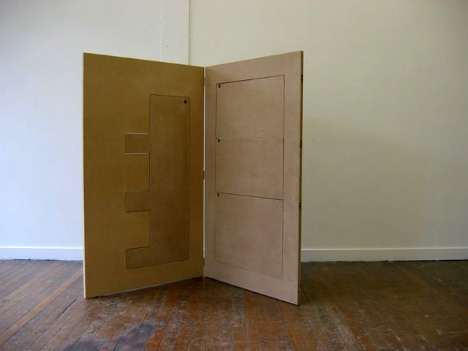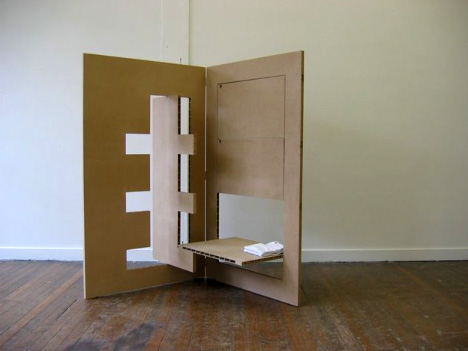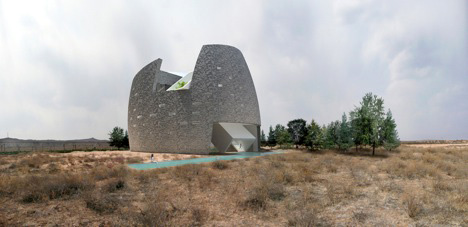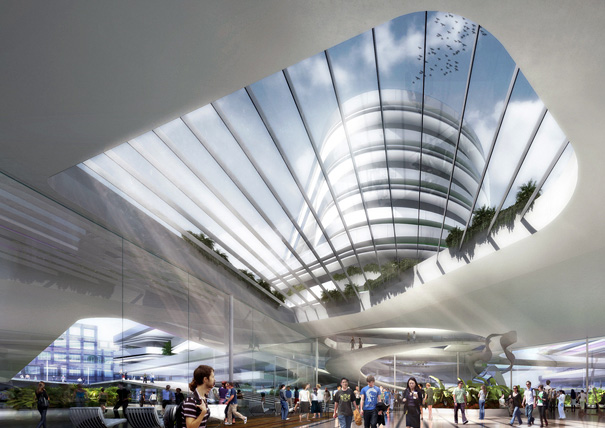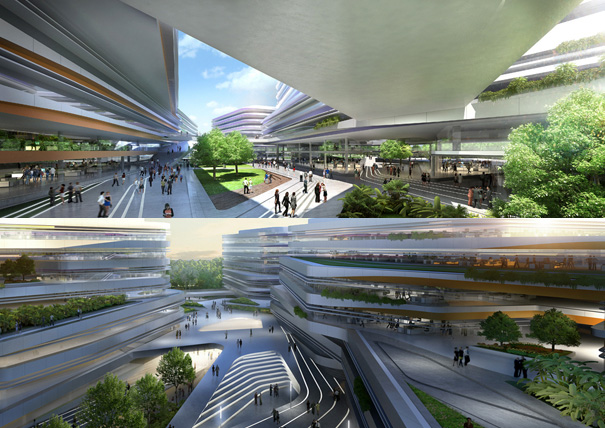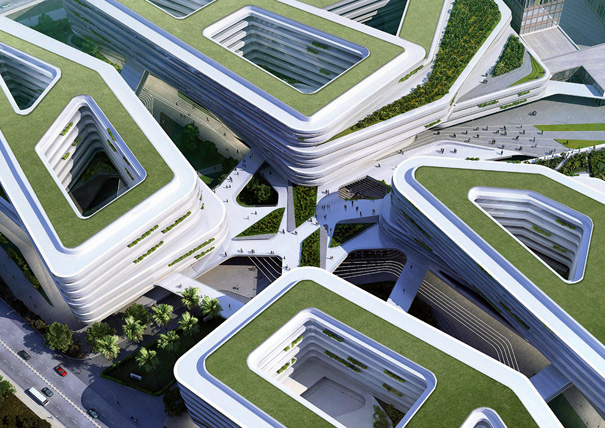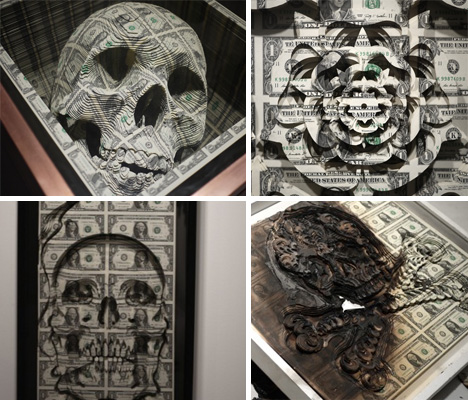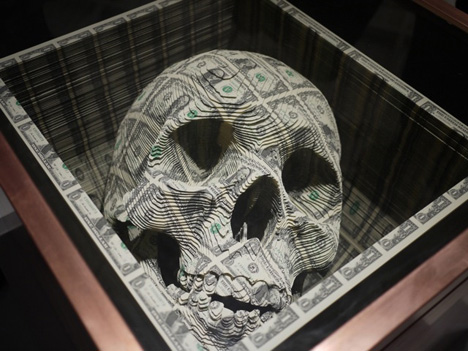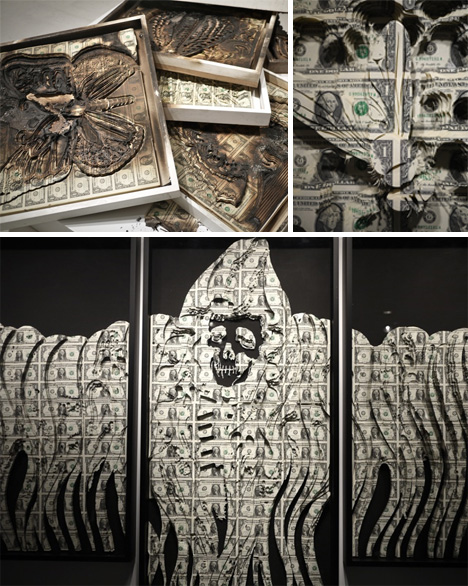The 2011 Skyscraper Competition is an endeavor to revolutionize efforts, vision and passion that architects put into building our future infrastructure. The projects have been adjudged for their use of new technologies, materials, programs, aesthetics and spatial organizations, along with studies on globalization, flexibility, adaptability, and the digital revolution. Hosted by the eVolo Magazine, the focus of the jury has been to pick out those ideas that understand architecture and its relationship with the natural and built environments.
First Place: LO2P: Delhi Recycling Center by Atelier CMJN, Julien Combes & Gaël Brulé

LO2P skyscraper is destined for New Delhi, the highly polluted capital city of India. Reminding you of the London Eye, this Ferris wheel like structure is built using old cars recycled for sourcing building material for the new structure. The surrounding air will be purified through a series of large-scale greenhouses that serve as filters. Another set of rotating filters capture the suspended particles in the air while the waste heat and carbon dioxide from the recycling center are used to grow plants that in turn produce bio-fuels.
Second Place: Flat Tower by Yoann Mescam, Paul-Eric Schirr-Bonnans & Xavier Schirr-Bonnans

The Flat Tower is a new high-density typology that features a medium-height dome structure with perforated cell-like skylights. The dome’s large surface area is the ideal location to harvest solar energy and collect rainwater. The structure houses community recreational facilities at the ground level, residential and office are located at the upper cells. An automated transportation system connects all the units, which are different shapes according to their program. This project has been designed for the city of Rennes, France, in an old industrial area but can be adapted to fit any location.
Third Place: Re-imagining the Hoover Dam by Yheu-Shen Chua

At the present moment one can visit the Hoover Dam and partake amenities like a viewing platform, a bridge, and a gallery. But the problem is that they are located at different areas of the site. With this redesign project, Yheu-Shen Chua brings together all the focal points of the amenities plus adds in a vertical aquarium to enthrall the visitors.
Honorable Mentions
NeoTax: Three-dimensional City Grid by Studio DMTW – Marc Anton Dahmen, Rene Lierschaft & Anna-Maria Wiedekind

NeoTax is basically a three-dimensional city grid that is organized in a horizontal and vertical street grid. The network is based on a modular system where each module can be viewed as a separate quarter or neighborhood.
PoroCity: Rehabilitation for Mumbai, India by Khushalani Associates – Rajiv Khushalani, Thomas Kariath & Mihir Sanganee

Dharavi in Mumbai is one of the largest slums in the world and the Porocity is an effort to rehabilitate this area. The design is derived from a progressive subdivision of a right-angled Sierpenski’s Pyramid. Features include small self-divisible units that are 3m x 9m blocks, divided into collective housing units with north facing terraces, community spaces, small-scale infrastructure like clinics and supermarkets, educational institutions, factories, and offices. It is a car-free environment where means of vertical, horizontal and diagonal access is through elevators, moving walks, escalators, and funiculars.
Tower for the Dead by Israel López Balan, Elsa Mendoza Andrés, Moisés Adrián & Hernández García

This project is an underground vertical cemetery for Mexico City.
Fish Tower by Hsing-O Chiang

The Fish Tower is a prototype for a vertical fish farm that could be up to 30 times more efficient than traditional farms. It features a fisherman’s market and visitors center at ground level. The fish farms are designed based on the research and analysis of habitation and movement of specific fish species. Finally there is a section that is dedicated to R&D.
Sports Tower by Sergiy Prokof`yev & Olga Prokof`yeva

Sports Tower is a vertical complex that accommodates a variety of sports facilities in one site.
RE:pH – Coastscraper by Gary Kellett

The underpinning concept for the Coastalscraper is to reduce the acid levels of the oceans by adding fossilized Coccolithophores to the water. The perfect location for the project is the southeast corner of England, with a vast geological swathe of Coccolithophore (white chalk) spanning from the outskirts of London, and terminating in what is known as The White Cliffs of Dover.
Iceberg Autonomy: Oil Recovery by Akram Fahmi

The Iceberg Autonomy is an enclave, a seascraper of suspended oil collectors and separators – a new water-world in constant navigation.
Tourist City Skyscraper by Francisco Villeda, Heechan Park, Wouter Dons & Sandra Fleischmann

Tourist City is a proposed cluster of mega-structures in Cancun, Mexico that will keep a check on unplanned urban sprawling.
Rhizome Tower: A Thousand Underground Plateaus by Enrico Tognoni, Federico Tinti & Davide Mariani

The Rhizome Tower is an underground city and something out of a surreal fantasy! It’s essentially a ‘Groundscraper’ that harvests natural resources above and below ground while creating a new living typology. The idea is to cultivate a self-sufficient underground city and maybe even develop a nation or two in the process! The entire setup is divided into 4 layers that is organized around a central core. The first layer is above the surface and contains the recreational, and food production facilities, with agriculture fields, farms, and glasshouses. The entire façade is covered with photovoltaic cells to harvest solar energy and specific locations are also equipped with wind turbines. The second layer, approximately 60 levels, is the residential part, with a diverse range of living quarters according to family sizes. The third and fourth layers are used as offices, and service areas with the deepest part of the project dedicated to the study and harvest of geothermal energy.
Borough no. 6 – New York City by John Houser

Borough no. 6 occupies the space between 22nd and 14th street and 6th and 7th avenue in New York City. This grid-like structure houses infrastructure like train stations, parks, homes, offices etc. The ideal urban Utopia!
Singapore’s Waterfront by Giorgi Khmaladze

As the name suggests, Singapore’s Waterfront is intended as an extension of the financial district in Singapore. The structure emphasizes on the proper harvesting of resources like rainwater, natural ventilation and sunlight. The tower is positioned at a 20-degree angle to the site to face the nearby waterfront. Each residence or villa consists of a two-storey apartment and shaded private garden. A hotel and offices are located in the middle levels, where the porosity of the building changes from a series of small openings to larger ones.
Moonscraper by Luis Quinones

Lets go and live on the moon, the Shackleton Crater Rim on the South Pole of the Moon! No kidding, this project is located precisely there and it looks at moon being our home-sweet-home of the future!
Floating Olympic Complex by Andrew Chow Wai Tat, Tao Huang & Xue Liang Zhang

The main idea behind the Floating Olympic Complex is to create the first vertical Olympic architecture with large-scale inverted skyscrapers that will serve as host to the games and will later be transformed into a floating city with housing, offices, recreational areas, and infrastructure already in place. The design has several inspirational references, which include an umbrella shell structure, mushroom, and stalactite formations. This project is envisioned for the forthcoming games in Rio de Janeiro, Brazil.
North Pole Skyscraper: A Trading Post for the World’s Freight Industry by Borja Muguiro

Proposed as the hub for shipping activities in the Arctic region, the North Pole Skyscraper slices vertically through the Arctic ice-shelf. It is an open structure that holds containers in multiple levels or platforms that serve as transaction posts between countries.
The On Demand Experience by Benjamin Feenstra & Jelmer Frank Wijnia

Here is a futuristic concept where the facilities arrive at your doorstep without you having to budge an inch! You need a golf course, a doctor, a movie…. demand and it will be there!
Waste Collector Skyscraper by Agata Sander & Tomek Kujawski

The Waste Collector Skyscraper is a recycling plant in the middle of the city. This specific project is designed for the Huangpu district in Shanghai, China. The structure has the potential to recycle 400 tons of MSW daily, in a comprehensive, clean, and self-sufficient process without intensive land use.
Hopetel: Transitional High-rise Housing by Asaf Dali

Here is a project based on transit housing for folks left roofless due to the economic crunch and calamities. An external skeleton with an open-scheme floor plan provides the base for internal tent structures and basic amenities like beds, showers etc. Shared amenities like laundry, storage and kitchen are also provided for.
3D Green: Vertical Farmland Inserted in an Existing Urban Fabric by Yiqing Jiang & Ying Tao

This project examines the idea of developing a vertical park and farm between skyscrapers in Shanghai, China.
Seeds of Life Skyscraper by Osama Mohamed Elghannam, Karim Mohamed Elnabawy, Mohamed Ahmed Khamis & Nesma Mohamed Abobakr

A dwelling for the newly liberated Cairo is based upon construction materials sourced from the recycled waste gathered from the city’s bin. The project is composed of an exoskeleton where different types of living and working units could be plugged-in.
Living Mountain: Solving Overpopulation by Anna-Maria Simatou & Marianthe Dendrou

The Living Mountain is a city-like skyscraper for one of the Earth’s harshest environments: the desert of Taklamakan, in the northwestern region of China. This high-rise structure mingles with man-made lakes and the housing areas are percieved as “living pods” of 2,000 square-feet with easy access to all the facilities. Rainwater is collected and circulated on top of the super-structure and freely cascades to the atrium while filtering the air and promoting the growth of indoor vegetation. Quite an oasis in the desert!
Tree of Life Skyscraper by Svirid Denis & Gudzenko Anastasiya

The Tree of Life is a skyscraper proposal for open mines around the world with an autonomous ecosystem. The lower end of the structure or the root, hosts the power station that harvests geothermal energy and includes a subterranean water purification plant. The stem is an external frame that provides stability to the structure. Pneumatic elevators offer transportation and the crown hosts the public area with housing sectors, offices, schools, and entertainment facilities. Attached to these structures there are a series of pods or terraces that are used as geoponic greenhouses, covered with solar panels and wind turbines.
Hydra Skyscraper by Milos Vlastic, Vuk Djordjevic, Ana Lazovic & Milica Stankovic

Hydra is a skyscraper that looks into the possibility of using Hydrogen power for consumption. The power is produced through electrolysis and could be stored in batteries and transported by truck, pipes or cables. The structure’s exoskeleton is built from grapheme. The project aims to harvest energy from lightning storms and store the power in several mega-batteries located at the base. It also features a research facility, housing, and recreational areas for scientists and their families.
Oil Platforms Transformed into Sustainable Seascrapers by YoungWan Kim, SueHwan Kwun, JunYoung Park & JoongHa Park

This project aims at transforming oil platforms around the world into sustainable seascrapers that produce and store fresh water. A modernized rig with all futuristic housing facilities.
Tensile Tower by David Gull & Jin Young Song

In the Tensile Tower project tensile cables suspended from the top of the mega column support the perimeter edges of the floor slabs. These cables spiral the tower at an angle in both directions, creating a diagonal configuration that provides resistance to torsion and overall stability.
Elevated Connectivity by Adam Nakagoshi, Thao Nguyen

The three-tier Elevated Connectivity is a high-rise proposal that creates a new urban grid above the city by connecting existing skyscrapers. The ground floor remains public and mainly used for transportation. The middle layer is dedicated to residences and offices while the third strata houses leisure and entertainment activities.
Rollin’ and Tumble: Vertical Amusement Park for Times Square by Dalho Yang & Seungdon Jung

The name says it all; a rollercoaster for the famous Times Square! It is an exploration of transportation in three dimensions, which has never been tested and tries to break the norm of using elevators and horizontal corridors.
Barbed-wire Skyscraper by Hyunbeom Cho, JinKyu Pak, HongSup Kim, Jiwon Kim

The Barbe-wire Skyscraper is based on the idea of a unified Korea in the near future and the importance of preserving the untouched natural habitat of the DMZ. The intention is to showcase museum and ecological reserve, where visitors will enjoy different sports facilities and outdoor recreational areas.
Lady Landfill Skyscraper by Milorad Vidojević, Jelena Pucarević & Milica Pihler

Lady Landfill Skyscraper is a bid to remove the Great Pacific Garbage Patch via a series of underwaterscrapers or floating islands. The structure comprises of self-sustained nodes that are organized by function hierarchy with four communication cores that connect three main programs – collectors at the bottom, recycling plant in the middle levels, and housing and recreational levels atop.
Kinetic Skyscraper by Victor Kopieikin & Pavlo Zabotin

The Kinetic Skyscraper has three main programs with a geothermal plant at the base, housing and offices in the upper levels, and a solar plant powered by thousands of photovoltaic panels on the façade. It even features a slew of kinetic housing units attached to a main exoskeleton. These units resemble a flower and are able to open, close, and direct towards sunlight.
Chernobyl Skyscrapers Network by Mengni Zhang

Chernobyl Skyscrapers Network is the reconstruction of a post apocalyptic environment around the Chernobyl power plant, Ukraine.
White Cloud Skyscraper by Adrian Vincent Kumar, Yun Kong Sung

The White Cloud Project is an air purification network of skyscrapers and is shaped as inverted buildings with ample public space at its base and residence and offices clustered on top. A fine membrane that cleans the air through an ingenious filtering process covers the structure. The air particles are trapped by the cloth-like structure and washed away by a constant mist. At the same time the collected dust is transported through a secondary branching system to a brick factory on the bottom.
Coalesce Skyscraper by Justin Oh

The final height of this skyscraper has not yet been decided, as perpetual development of the project has continued for more than twenty years! What is evident is that over the years, the distinct architectural style of each year, is reflected in each developing layer.
http://www.yankodesign.com/2011/03/09/35-amazing-award-winning-skyscraper-designs/
